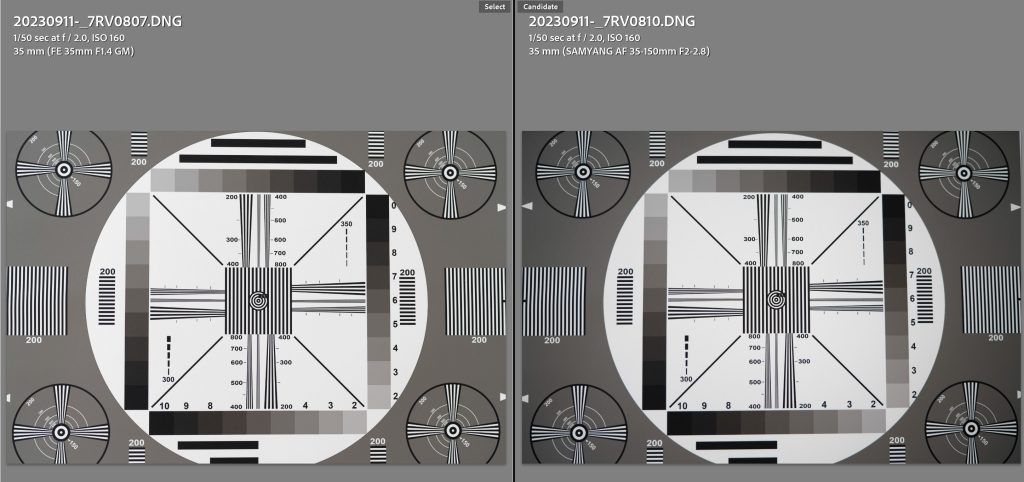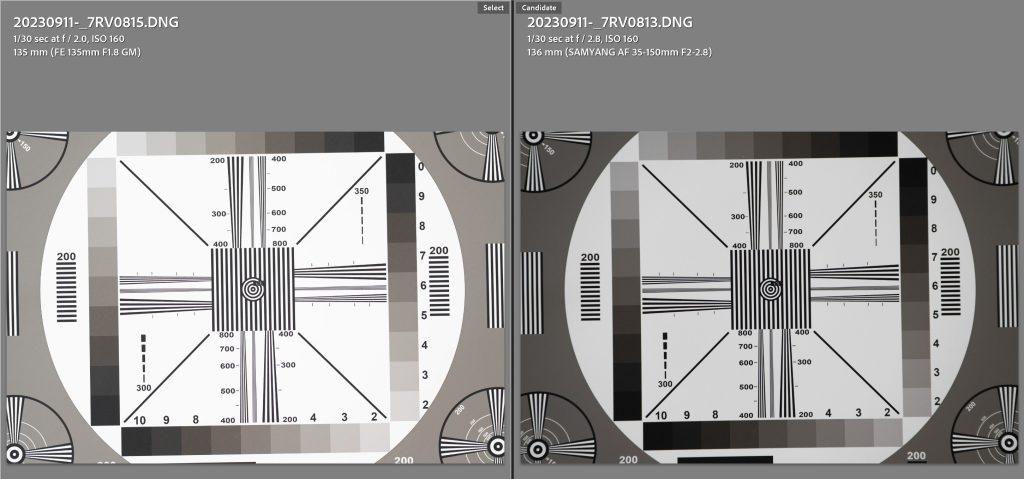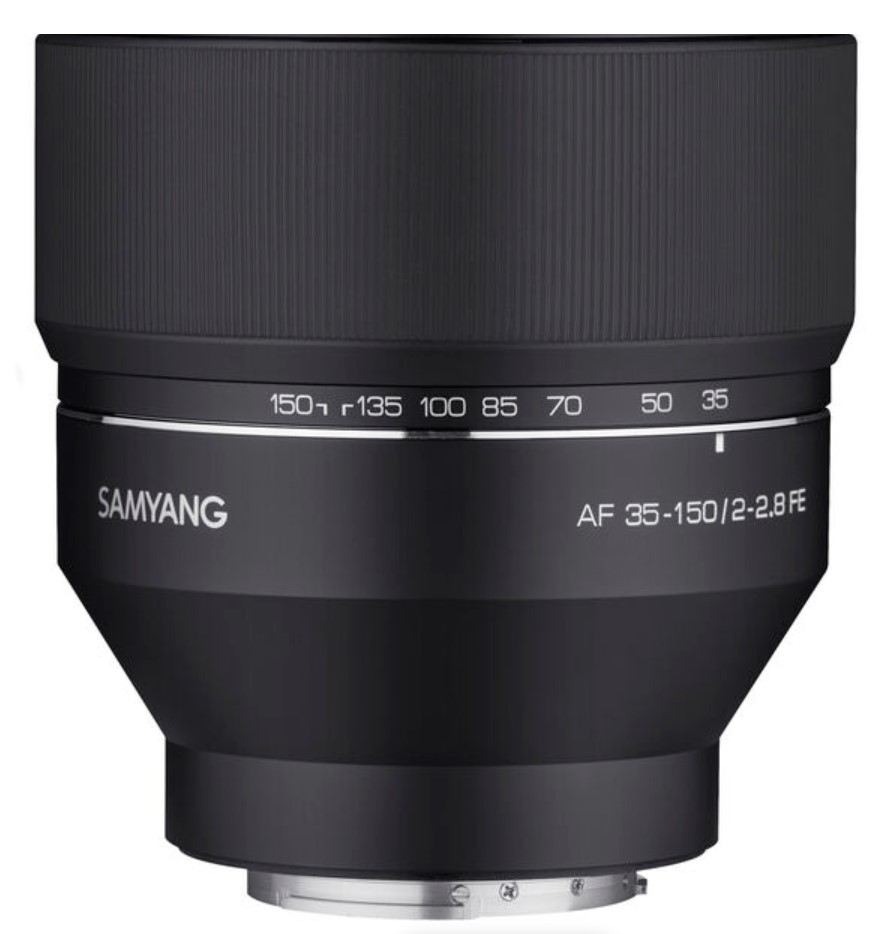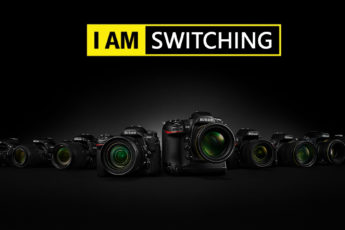
I will start with this: I so much wanted Samyang 35-150mm to be my “only lens I needed”. Well, at least for most of the time – shooting events, portraits, and why not travels. But before I discover to you why this was not the case, and the lens was soon returned, I want to share some image comparison between the Samyang and two of the Sony GM lenses – the 35mm and the 135mm.
Let’s start with the Sony 35mm 1.4 GM and how it compares with the Samyang 35-150mm at its widest end – 35mm at f/2.

As you may immediately see from the full chart image (and this will be the setup image for my comparison), there is some exposure difference between the two lenses. The Sony is a bit sharper – at least a third of the stop. I also did three shots with each lens and then selected the best ones to compare.
During the entire article the Sony images will be on the left side and the Samyang images will be on the right.
I shot the two lenses at f2, as I wanted to show what they are capable of in equal aperture settings (Sony’s one full stop advantage – up to f/1.4 was not considered for this test). As you can see, when expanding the images, Sony absolutely dominates in terms of sharpness. The difference is very visible in the center and even more so at the extreme corners. Pay attention especially to the top-right corner, where Samyang is so soft and fuzzy, compared with its GM brother.
Vs. 135mm 1.8 GM

Things are almost the same with the bigger brother – the 135mm GM. We now have almost one full stop difference in exposure, which means that the already big advantage for Sony is even bigger in real life. The Samynag has one advantage here though – it looks wider at 135mm than the Sony 135mm GM. And I mistakenly set the Samyang to 136mm, as the distance between the 135mm and 150mm on the barrel is extremely small, and it is very hard to be precise (see the image below).

At 135mm I made another mistake, by not paying attention that the Samyang is a variable aperture lens, and at the tele-foto end will be at f/2.8, instead of f2. That’s why there is almost a one stop difference in exposure, which you see on the images.
As you can see when expanding the images, the GM lens outperforms the Smayang with a big margin. It is just sharp, sharp, sharp – from center to corner – in any direction. And that is expected – first, the Sony lenses I used for this comparison are primes, then they are Sony’s professional GM series, and lastly they cost way more than the Samyang. Which brings me back to why I actually returned the Samyang lens. It has nothing to do with the sharpness, not the weight and size. Well, maybe the weight a little bit, and I’ll explain in a bit.
The main reason I returned the lens is… the lens creep. I never had a lens that expands its barrel so fast, even if you just slightly tilt it downwards, and never thought the lens creep would be something I will not be able to deal with, and will drive me crazy so much. When I took the lens to a sports event I really appreciated the zoom range. I was able to open wide when the players were close, and zoom in when they were far on the field. On the A7R V I was shooting with, I had one of the system buttons set to APS-C mode, so I could quickly switch from 35mm all the way to 225mm – which was invaluable for this shooting.
But let’s say I shoot at 35mm, and at the moment I looked at the back of the camera to preview the image, the lens was sliding down to 150mm. Yes, the lens has a lock button to lock at 35mm, but it is not usable during a photoshoot, as it does not “unlock” automatically after, when you try to zoom. Plus, even if it did so, the workflow of shooting-locking-previewing-shooting would not be convenient either.
Before I returned the lens I sent a message to Samyang to ask if they have any solution or a recent fix for this, and also asked if they have a collar ring, as I did not see any on the internet. They responded with a message that I may try to order another copy, although “a new lens may have less creep than you are describing but it will not solve the problem completely. We do have a collar ring in development but it is not yet available.”
So at least the good news, directly from Samyang, is that a new collar ring is coming in the near future, but there is no one at the moment. I could only find third party ones for the Tamron version of the lens, as it was over one year older than the Samyang. And with a weight of 2.91 lb. (1.32 kg) I really was not feeling comfortable to put it on a tripod and damage the lens mount of my camera.
Ending words
And that will be all for today – I really wanted this lens to work for me. I liked the zoom range. Trust me, you really can cover most of the events with just this lens. I like its sharpness, despite the comparison with the Sony GM lenses above. And even the weight is not that prominent if you hold and support the lens with your hand. But the severe lens creep, and partially the lack of a collar ring at the moment, made me return it and look elsewhere. And that most probably would not be the older brother from Tamron, as it sometimes hunts between the background and the object (as shown on several video reviews online).
But let’s wish a little – Sony, please give birth to a nice companion to your amazing new 16-35mm GM II, creating a solid duo for about everything. A smaller, lighter, and stabilized new lens…
35-120mm (or 35-105mm) f/2.8 GM maybe…?
Hopefully you read and listen!














